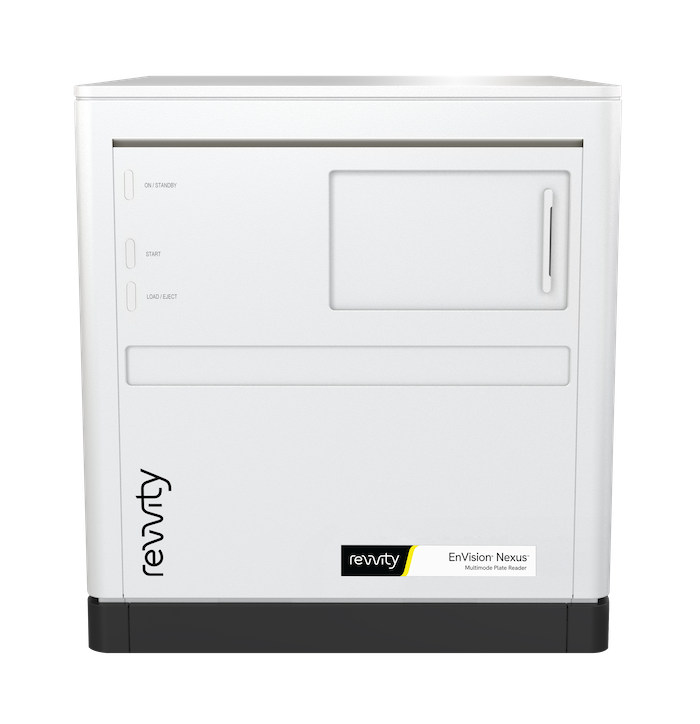EnVision 2105 Multimode Plate Reader
 2018 Winner of SelectScience® Seal of Quality
2018 Winner of SelectScience® Seal of Quality
Seals of Quality recognize the top 0.1% of laboratory products that consistently receive the highest customer review ratings and are designed to further assist scientists worldwide in making important purchasing decisions for their labs.
Our gold-standard for high-throughput screening, the EnVision provides exceptional sensitivity and speed with minimal downtime – backed by our global network of application scientists and engineers.
Our Alpha and LANCE® reagents are developed and optimized on the EnVision plate reader so you can be confident of accurate results. Plus, we can cite over 15,000 published papers that attest to its real-world performance across a broad range of applications.
Our state-of-the-art, dual-detector model is among the fastest HTS readers in the market.
Choose from detection technologies including AlphaScreen®, AlphaLISA®, fluorescence, ultra-sensitive luminescence, absorbance, time-resolved fluorescence (TRF) and TR-FRET, for example to detect Revvity’s DELFIA and LANCE assay technologies.
- Time resolved fluorescence certified for use with HTRF® technology
- Maximum speed and sensitivity with proprietary Direct Optics™ technology
- Hybrid system combining filters for sensitivity and monochromators for assay flexibility
- Laser excitation technology for time-resolved fluorescence modes for the best available TRF performance
- Laser technology for high throughput for AlphaScreen assays
- Low detection levels for high throughput screening applications so you can be confident that you are not missing any leads.
- Two configurations are available, which both offer the same unsurpassed sensitivity and analytical performance
The EnVision 2105 HTS multimode plate reader – a super-fast, dual-detector reader designed specifically to support demanding high-throughput discovery applications.
The EnVision 2105 XCite multimode plate reader – a single-detector system ideal for the most challenging research and assay development applications. The EnVision XCite multimode plate reader is upgradeable to the EnVision HTS multimode plate reader.
Technologies included:
- Filter based fluorescence intensity (top and bottom)
- Time-resolved fluorescence (top and bottom)
- Luminescence, including glow, flash and dual luminescence
- Filter-based absorbance
- Fluorescence Polarization
- Optional technologies
- Standard AlphaLISA®/AlphaScreen®/Alpha
- High-throughput AlphaLISA®/AlphaScreen®/Alpha
- Monochromator-based fluorescence intensity
- Monochromator-based absorbance detection
- Laser-based time-resolved fluorescence
- Ultra-sensitive luminescence
Key Features
- Proprietary Direct Double Optics™ deliver a full lens system for maximum speed and sensitivity (EnVision 2105 HTS system only)
- The fastest mode uses an innovative “on the fly”-detection – making EnVision exceptionally fast in measuring absorbance or fluorescence intensity on a 1536-well plate – less than 36 seconds including plate loading times
- Field upgradeable for changing application needs
- User-changeable, label-specific optical mirror modules and filters for assay customization with positive identification of measurement configuration (barcodes)
- Integrated barcode reading enables barcode reading from short right side and both long sides of the plate
- Optional 21 CFR Part 11 support
Options
- 2 channel dispenser
- Plate stacker (20 or 50 plates)
- Temperature control up to 55ºC
- Compatible with a wide range of automation systems
- Spotfire® Analyst for Multimode Detection (MMD) is tailored to the analysis of plate reader data and enables you to visualize, correlate, compare and analyze your data and share freely with your colleagues
Outstanding Support
We understand your science and applications. Combine many years’ experience developing and supporting multimode plate readers and reagents with a global network of application scientists and engineers, and you can be confident of minimal downtime.
You can also access our Application Support Knowledge base (ASK) which provides a comprehensive set of technology-specific and application-specific scientific articles, written by our R&D, technical support, and applications teams, enabling you to access scientific support 24 hours a day/7 days a week.
Part of a Total Solution for Screening
EnVision is part of our complete solution for screening. For high-throughput screening, we offer assays and reagents, radioimmunoassays and radiometric detection, microplates and automation, in addition to multimode plate readers. We also offer solutions for phenotypic screening such as high-content screening systems and for data analysis such as Signals™ for Screening.
Recent publications:
- Antibody profiles to wheat germ cell-free system synthesized Plasmodium falciparum proteins correlate with protection from symptomatic malaria in Uganda. Kanoi, Bernard N et al. Vaccine (2017), 35(6): 873-881. doi 10.1016/j.vaccine.2017.01.001.
- Novel Small Molecule Entry Inhibitors of Ebola Virus. Basu, Arnab et al. The Journal of Infectious Diseases (2016), 212 Suppl 2:S425-34. doi: 10.1093/infdis/jiv223.
- A novel multiplex assay for simultaneous quantification of total and S129 phosphorylated human alpha-synuclein. Landeck, Natalie et al. Molecular Neurodegeneration (2016), 11(1):61. doi: 10.1186/s13024-016-0125-0.
- Development of two novel high-throughput assays to quantify ubiquitylated proteins in cell lysates: application to screening of new anti-malarials. Mata-Cantero, Lydia et al. Malaria Journal (2015), 14:200. doi: 10.1186/s12936-015-0708-1.
- Effect of protein aggregates on characterization of FcRn binding of Fc-fusion therapeutics. Bajardi-Taccioli, Adriana et al. Molecular Immunology (2015), 67(2 Pt B):616-24. doi: 10.1016/j.molimm.
- Aptamer-mediated nanoparticle interactions: from oligonucleotide-protein complexes to SELEX screens. Evadé, Laetitia et al. Methods in Molecular Biology (2015), 1297:153-67. doi: 10.1007/978-1-4939-2562-9_11.
- Autoantibody Profiles in Collagen Disease Patients with Interstitial Lung Disease (ILD): Antibodies to Major Histocompatibility Complex Class I-Related Chain A (MICA) as Markers of ILD. Furukawa, Hiroshi et al. Biomarker Insights (2015), 10:63-73. doi: 10.4137/BMI.S28209.
- Structural basis of AMPK regulation by adenine nucleotides and glycogen. Li, Xiaodan et al. Cell Research (2015), 25(1):50-66. doi: 10.1038/cr.2014.150.
- Serologic assay for diagnosis of celiac disease based on a patient-derived monoclonal antigliadin antibody. Steinsbø, Øyvind et al. Gastroenterology (2015), 149(6):1530-1540.e3. doi: 10.1053/j.gastro.2015.07.008.



